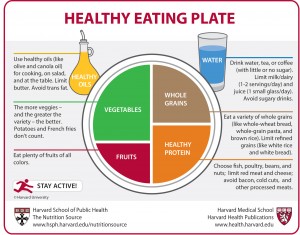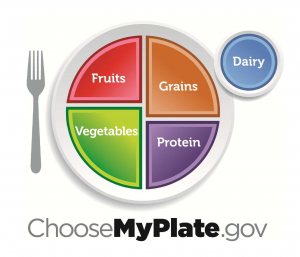June is Dairy Month, and at the risk of being thrown out of Wisconsin, I will say that dairy has its pros and cons. Contrary to what the USDA recommends you do not need to consume dairy products daily. Some people can enjoy dairy as part of a healthy diet, but many others cannot and should not consume dairy products.
Here are some frequently asked questions about dairy:
Do we need dairy in our diets?
It really depends upon who you ask. The USDA recommends three servings of dairy daily, but many nutrition experts will tell you dairy is optional or that you should avoid it completely.Check out the difference between the Harvard Plate and the USDA Plate and you can see they are quite similar, but Harvard has left out the milk. Why? According to the Harvard School of Public Health website: The Harvard Healthy Eating Plate is based exclusively on the best available science and was not subjected to political or commercial pressures from food industry lobbyists. Read full article

Harvard School of Public Health: Milk is NOT included as part of each meal They recommend one to two servings of dairy daily

USDA plate: Recommends 3 servings of dairy per day and implies drinking a glass of milk with each meal.
Dr. Mark Hyman, author of Ultra Metabolism argues against daily milk consumption: “From an evolutionary point of view, milk is a strange food for humans. Until 10,000 years ago we didn’t domesticate animals and weren’t able to drink milk (unless some brave hunter-gather milked a wild tiger or buffalo!). If you don’t believe that, consider this: The majority of humans naturally stop producing significant amounts of lactase — the enzyme needed to properly metabolize lactose, the sugar in milk — sometime between the ages of two and five. In fact, for most mammals, the normal condition is to stop producing the enzymes needed to properly digest and metabolize milk after they have been weaned. Our bodies just weren’t made to digest milk on a regular basis. Instead, most scientists agree that it’s better for us to get calcium, potassium, protein, and fats from other food sources, like whole plant foods — vegetables, fruits, beans, whole grains, nuts, seeds, and seaweed.”
How do I know if I should give up dairy?
Try an elimination diet. Cut dairy out of your diet completely (no milk, cheese, yogurt, or ice cream) for two weeks and see if you feel better.
You may notice improvements with the following: · acne · sinuses · post-nasal drip · headaches · irritable bowel syndrome · body weight
After two weeks start eating dairy again and see how you feel. If you feel worse, you should try to give it up for life. If you don’t see any changes after eliminating dairy (except for craving ice cream) and you don’t note any difference when you add them back into your diet then you can probably continue to eat dairy on a limited basis.
Should I eat/drink low-fat or no-fat dairy products?
Here’s an excerpt from TIME magazine, March 2015: “In terms of obesity, we found no support for the notion that low-fat dairy is healthier,” says Dr. Mario Kratz, first author of the review and a nutrition scientist at the Fred Hutchinson Cancer Research Center in Seattle. Of the 25 studies included in his team’s review, Kratz says 18 reported lower body weights, less weight gain, or a lower risk for obesity among full-fat dairy eaters. The other seven studies were inconclusive. “None of the research suggested low-fat dairy is better,” he says.
According to Michael Pollan in his book In Defense of Food: “To make dairy products low fat, it’s not enough to remove the fat. You then have to go to great lengths to preserve the body or creamy texture by working in all kinds of food additives. In the case of low-fat or skim milk, that usually means adding powdered milk. But powdered milk contains oxidized cholesterol, which scientists believe is much worse for your arteries than ordinary cholesterol, so food makers sometimes compensate by adding antioxidants, further complicating what had been a simple one-ingredient whole food. Also, removing the fat makes it that much harder for your body to absorb the fat-soluble vitamins that are one of the reasons to drink milk in the first place.”
How much dairy should I eat?
As mentioned earlier, it depends upon who you ask. The USDA recommends three servings; Harvard School of Public Health recommends one to two servings and many other experts will say to skip it altogether. That leads us to another good question…
What is a serving?
At XO Fitness we have adopted Precision Nutrition’s advice and advise clients to use their hand to judge their serving sizes. Some dairy products are considered a protein such as cottage cheese so a serving would be the size of you palm (Men can have two servings while women should have one). Others are very high in fat (such as butter or cheese) so the serving size is one to two thumbs. In most cases, we recommend referring to the label on the package. Milk (skim & 1%) is not are considered a protein, but instead it is classified as a carbohydrate because is has a lot of sugar (lactose).
What are some good milk alternatives?
Lisa Leake, author of 100 Days of Real Food, suggests that if you drink milk alternatives you should be sure to choose those that are unsweetened. Her top choices would be either unsweetened full-fat coconut milk or almond milk…or even brown rice milk. She does not recommend soy milk because soy is already an additive in so many packaged foods.
Do I need dairy for healthy bones and teeth?
No. If you want healthy bones, get plenty of weight bearing exercise and supplement with 2,000 IU of vitamin D daily. In fact, some parts of the world with the lowest incidence of osteoporosis also have very low consumption of dairy.
What about getting enough calcium?
Dr. Hyman recommends getting your calcium from foods such as dark green leafy vegetables, sesame tahini, sea vegetables, and sardines or salmon with the bones.
So, here’s my two cents worth:
When it comes to dairy, the health effects seem to vary greatly between individuals. If it negatively affects you there is no harm in cutting it out of your diet. If you like dairy and it likes you then go ahead and enjoy it, but keep in mind the portion sizes mentioned earlier! Personally, I am able to consume dairy without any negative side effects. I avoid low-fat and no-fat dairy products, but eat cheese, cottage cheese, plain Greek yogurt, and use butter and half-and-half (coffee without it just isn’t the same). I choose not to eat meat, so I utilize dairy to help me get enough protein.Brief Disclaimer: XO Fitness, LLC and employees do not claim to be dietitians and cannot render specific nutrition advice related to a medical condition or provide detailed nutritional analysis. Individuals seeking these services should see a registered dietitian. The information in this article is meant to help the reader become more aware of the wide range of opinions on the consumption of dairy and encourage individuals to decide what is best for them.






